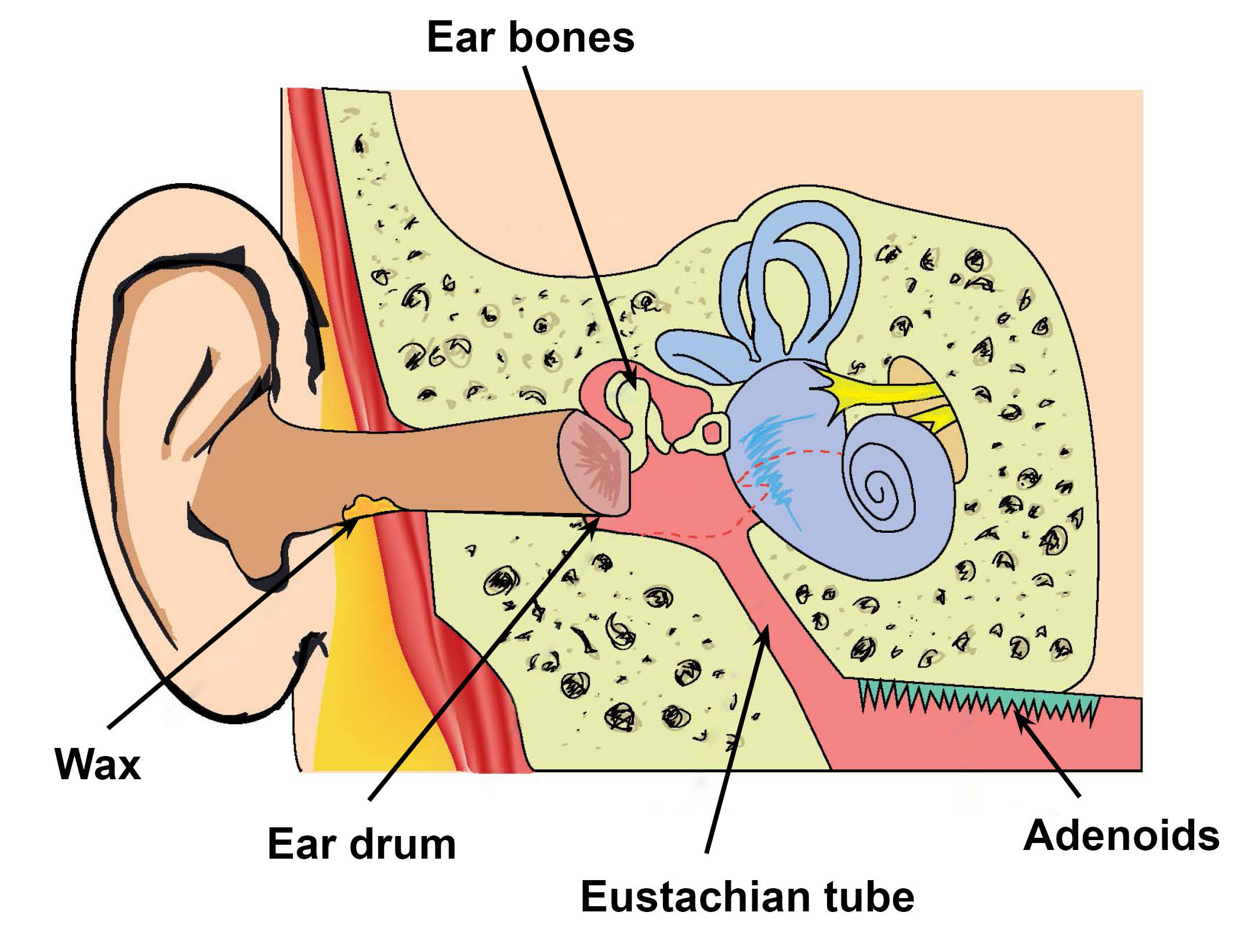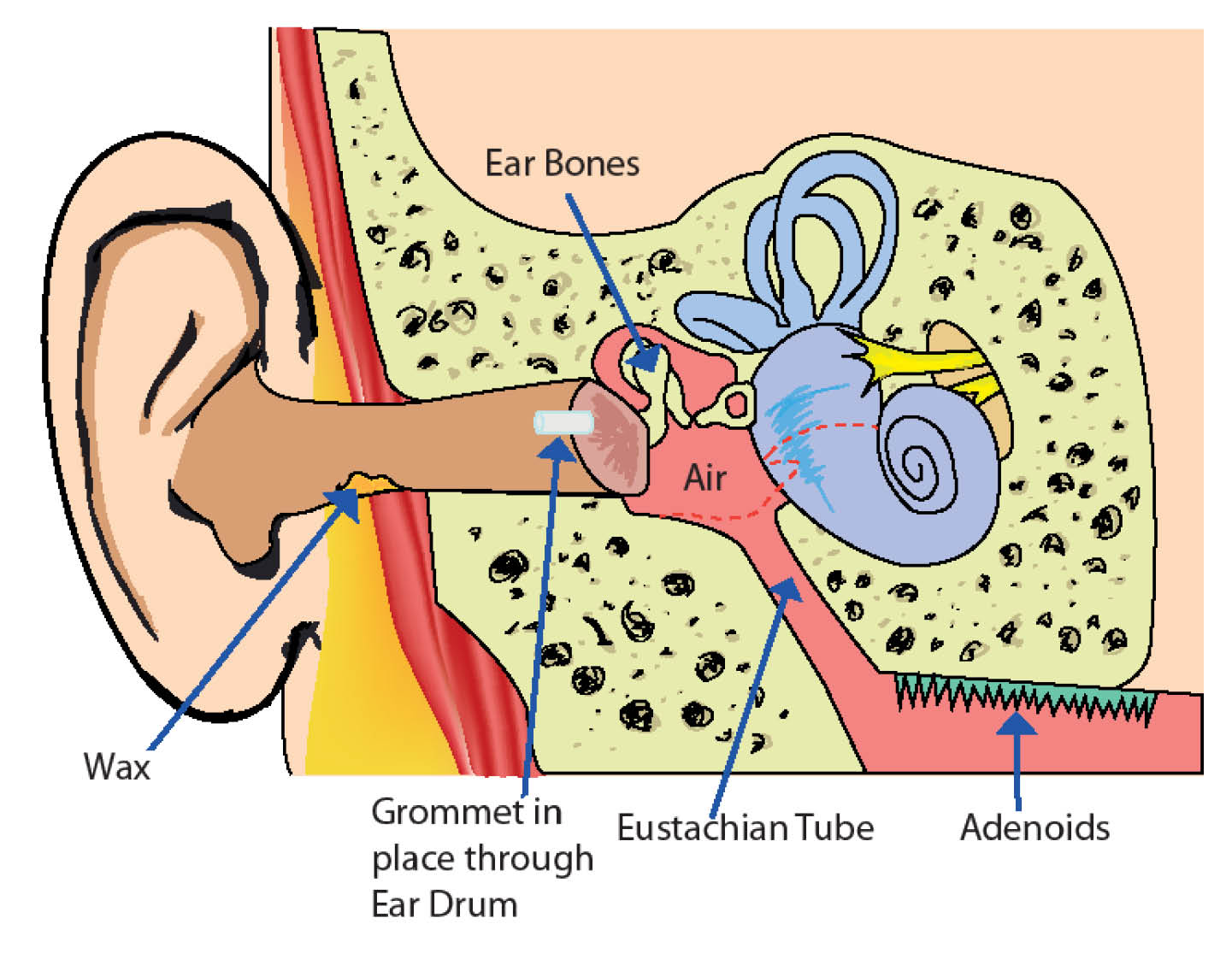Glue ear, grommets, and adenoids
Information for parents from the Ear Nose and Throat (ENT) Department
Your child has been diagnosed as having a problem with fluid or mucus build-up behind their ear drum; this is often called “glue ear”. This leaflet explains possible treatments that may be offered if your child’s condition continues.
How does a normal ear and hearing work?
The normal ear is divided into three parts - outer, middle, and inner ear.
The outer ear funnels sound waves in the air to the eardrum, which forms the boundary between the outer and middle ear. The eardrum vibrates when sounds arrive. The vibrations are transmitted to the inner ear via three small bones (ossicles) suspended in the middle ear.

The inner ear acts like a microphone, turning sound vibrations into electrical signals which are sent to the brain via the nerve of the hearing. The inner ear is also concerned with balance. To hear normally, the eardrum and ossicles must be able to move easily.
For this to happen the middle ear must contain air at the same atmospheric pressure as the outer ear. The air in the middle comes from the back of the nose via the Eustachian tube.
What is glue ear?

Glue ear is a build-up of fluid behind the eardrum in the middle ear. The fluid may be thick and sticky or thin and watery. Either way, it stops the eardrum and ossicles vibrating easily so quieter sounds are not heard.
Glue ear is the most common cause of deafness in children. Other names for glue ear are middle ear effusion and chronic secretory otitis media.
What causes glue ear?
Most children get glue ear after a cold or ear infection. The Eustachian tube is small and blocks easily. It then fails to ventilate the middle ear and sticky secretions cannot drain away, so fluids build up in the middle ear. Movement of the eardrum and ossicles is impaired (weakened or damaged), causing partial deafness. Most cases get better quickly after a cold. A small number continue for months or years.
Large adenoids at the back of the nose and passive smoking (inhaling smoke from other peoples’ cigarettes / cigars) are the most common reasons for glue ear to continue. Sometimes glue ear runs in families, although it is not strictly speaking hereditary. Often no cause is found.
What are adenoids?
Adenoids are cauliflower-like swellings of immune tissue at the back of the nose. Normal adenoids help fight off infections. If they get too big they cause blockage of the nose and Eustachian tube. In severe cases they can cause breathing to be obstructed at night.
What are the symptoms of glue ear?
Mild to moderate deafness is the most common symptom. It often varies from week-to-week, being worse after a cold.
If deafness happens early in childhood, speech may be delayed. Unclear speech and constant shouting are common.
Later education may be affected. Deafness is not always suspected and a child is thought to be inattentive, slow, or lazy, Concentration may be poor and the child often seems to be ‘in his or her own world’.
Some sufferers get regular earaches and repeated ear infections with high temperatures.
They may also have poor balance and be clumsy.
Older children often complain of noises in their ears.
What is the treatment?
The fluid can go away by itself, so ‘watching and waiting’ may be best. By the age of eight years many children have ‘grown out of it’, though this is only the average age. Some will carry on having trouble into their teens. Any factors that make the condition worse should be eliminated, especially passive smoking.
Antibiotics and painkillers, for example Calpol, can be used for ear infections. Decongestants, for example Sudafed, are often prescribed but have not been proven to work well.
Glue ear can be seasonal (worse in the winter and better in the summer) so any decision to operate may be delayed if your child is seen in the spring. An operation is more likely to be recommended in the autumn. The decision to operate is always based on the individual child. For immediate relief, myringotomy and grommet insertion works well. We may suggest removing your child’s adenoids if they are enlarged and where glue ear comes back after the grommets have been inserted.
What is a grommet and how does it work?

A grommet is a tiny plastic tube, shaped like a mini cotton reel, about 2mm across.
It is fitted through a small cut in the eardrum (myringotomy). The tension of the eardrum grips the grommet. The cotton reel shape prevents it falling in or out.
The grommet allows air from the outer ear directly into the middle ear. If the grommet remains in position and is not blocked, your child’s hearing will return to normal almost immediately. The grommet does not drain fluid out, it lets air into the middle ear.
It is designed to stay in position for about nine to 15 months. Then the eardrum heals over and the grommet drops out.
It is important to understand that a grommet does not cure the underlying cause of glue ear. It does provide highly effective and immediate relief of deafness and earaches while it is in position and working. This buys time and allows your child the chance to ‘grow out of it’.
If factors such as passive smoking are not dealt with, there is an increased risk that your child’s glue ear will come back once their grommets fall out.
How is the operation done?
Grommet insertion is a quick and simple day case procedure. It is very delicate and normally done under general anaesthetic (your child will be asleep). The anaesthetic is usually given by injection into a vein in the back of your child’s hand. To stop the needle from hurting, a local anaesthetic cream is usually applied beforehand.
A microscope provides a magnified view of your child’s eardrum. A small cut is made in their eardrum and the fluid in their middle ear is sucked out. The grommet is inserted and some ear drops given.
If your child’s adenoids are to be removed as well, this is normally done under the same anaesthetic. The adenoids are removed through your child’s mouth. No external cut is needed.
What happens after the operation?
Children recover very quickly from grommet insertion and should be able to go to school after a day or two.
Their hearing normally improves immediately but do not worry if there is still some difficulty in the first weeks as it can take time in some cases.
They may have a very slight earache, which you can treat with Calpol (paracetamol).
There may be slight bleeding from their ear in the first few days following surgery. This is normal and nothing to worry about.
After an adenoidectomy your child may be uncomfortable for up to a week after their surgery and have a sore throat, which can be treated with Calpol (paracetamol).
Your child should stay off school for seven to 10 days and should avoid contact with anyone who has a cold or other infection as there is a small risk of heavy bleeding from their nose. If this happens you should telephone the hospital and / or go to your nearest Emergency Department.
What about swimming and grommets?
Your child must not swim for the first two weeks after their surgery. After two weeks surface swimming is allowed without earplugs. If your child wishes to dive or use water chutes, they should wear some well-fitting silicone rubber earplugs.
Bath water is much worse than swimming pool water as it contains germs from the rest of the body and from soap, so should not be allowed in your child’s ears. Do not allow your child to put their head under the water in the bath. For hair washing, either use earplugs or a piece of cotton wool rubbed with Vaseline to provide a waterproof seal.
When cleaning your child’s ears, gently clean only the outer part of their ears and never use cotton buds.
Will fluid discharge from their ear after the operation?
In the first few days after their operation, there may be a slight discharge or bleeding from your child’s ear. This is normal and nothing to worry about. After that there should be no discharge. If their ear continues to run and is especially smelly, that means they have an ear infection.
The infection is best treated with quinolone ear drops, which can be prescribed by your GP. These must be inserted correctly with your child lying on one side with their affected ear facing up. The discharge should be mopped away gently. The drops must get right into the ear canal. You then massage the tragus (the piece of skin that sticks out just in front of the ear canal like an open trapdoor) to force the drops through the grommet into the middle ear. It is rather like plunging a blocked sink. The infection should clear up within a few days.
Antibiotics taken by mouth are not very good for treating ear infections where there is a grommet present.
What happens after the grommet comes out?
The grommet only helps while it is in your child’s eardrum and open. After it has fallen out, the eardrum heals over. In two out of three cases, the child’s hearing remains normal, there is no further build-up of fluid, and the condition is cured.
If the Eustachian tube is still blocked, the glue ear can come back and it may be necessary to operate again in one in three cases. Of patients who have a second set of grommets, about one in three will need a third (one in nine overall) and of those, one in three will need a fourth set (one in 227 overall) and so on.
Will my child have a follow-up appointment?
A follow-up hearing test will be arranged after six weeks. After that we advise that your child sees their GP once a year to see if their grommet is still in place.
Do grommets scar the eardrum?
Yes. But the scar does not have any noticeable effect on hearing. It is less of a problem than the scarring caused by repeated ear infections.
Contact details
If you have any queries or concerns, please contact one of the following.
Channel Day Surgery Centre, William Harvey Hospital, Ashford
Telephone: 01233 616263Day Surgery Centre, Kent and Canterbury Hospital, Canterbury
Telephone: 01227 783114Day Surgery, Queen Elizabeth the Queen Mother Hospital, Margate
Telephone: 01843 234499Dolphin Ward, Kent and Canterbury Hospital, Canterbury
Telephone: 01227 864052Padua Ward, William Harvey Hospital, Ashford
Telephone: 01233 651855
Further information
If you have any further queries or concerns, please speak to your doctor or consultant.